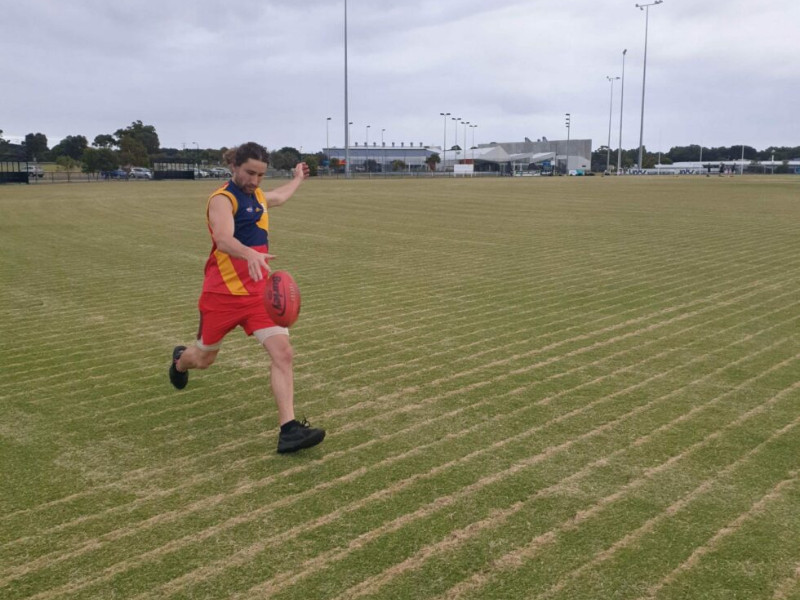Get excited Victoria: here comes a new (and hopefully full) season of Aussie Rules Footy! If you are an avid player of the game, a die hard fan or simply a casual spectator, no doubt you have heard of many football players who have ‘pulled a hammy’. This is with good reason, as hamstring injuries are the single most common injury sustained in the AFL and amateur football alike. What is a hamstring tear?  The hamstrings are a group of four muscles at the back of the thigh that bend your knee and extend your hip. Muscle tears come in three categories – Grade 1, 2 and 3. A grade 1 tear is a mild muscle strain which will be sore at the time of injury, will mildly swell and be tender for a couple of weeks. Grade 2 injuries can range from moderate pain at the time of the injury and mild swelling to severe pain, bruising and swelling. The reason for this is that there are torn muscle fibres, which commonly results in some weakness. A grade 3 hamstring tear is a complete rupture of the muscle either in the belly of the muscle, or at its attachment onto the bone. This is a less common but more serious injury and may require a surgical repair. Large amounts of bruising and swelling will occur and walking will be very painful and likely require crutches. Why do hamstrings tear? There are many factors that lead to a torn hamstring. Weakness and lack of flexibility in the hamstrings are a common cause for the muscles to tear because significant amounts of force are placed through the body in sports like football, especially when kicking and explosively sprinting. What can I do to prevent a hamstring injury? Luckily there has been a lot of research into the factors that contribute to hamstring tears so we are able to reduce the likelihood of sustaining an injury quite dramatically. Some ideas are: 1. Keep your hammies strong. Undertaking regular strengthening exercises for the hamstrings is very important. Doing exercises such as hamstring leg curls, squats, deadlifts and other more specialised exercises to lengthen and strengthen your muscles together will help dramatically. 2. Warm up: Don’t try to be a hero and run onto the ground bombing a torp from 50 at the start of training. Your muscles need time to increase their blood flow and elasticity. Starting with a light jog and some hamstring exercises can be an easy way to prevent an injury. 3. Be Mindful of Previous Injuries. If you have suffered a hamstring strain before, you are at a much higher risk of sustaining another. Keep this in mind and be even more vigilant at the sign of any tightness or discomfort.
The hamstrings are a group of four muscles at the back of the thigh that bend your knee and extend your hip. Muscle tears come in three categories – Grade 1, 2 and 3. A grade 1 tear is a mild muscle strain which will be sore at the time of injury, will mildly swell and be tender for a couple of weeks. Grade 2 injuries can range from moderate pain at the time of the injury and mild swelling to severe pain, bruising and swelling. The reason for this is that there are torn muscle fibres, which commonly results in some weakness. A grade 3 hamstring tear is a complete rupture of the muscle either in the belly of the muscle, or at its attachment onto the bone. This is a less common but more serious injury and may require a surgical repair. Large amounts of bruising and swelling will occur and walking will be very painful and likely require crutches. Why do hamstrings tear? There are many factors that lead to a torn hamstring. Weakness and lack of flexibility in the hamstrings are a common cause for the muscles to tear because significant amounts of force are placed through the body in sports like football, especially when kicking and explosively sprinting. What can I do to prevent a hamstring injury? Luckily there has been a lot of research into the factors that contribute to hamstring tears so we are able to reduce the likelihood of sustaining an injury quite dramatically. Some ideas are: 1. Keep your hammies strong. Undertaking regular strengthening exercises for the hamstrings is very important. Doing exercises such as hamstring leg curls, squats, deadlifts and other more specialised exercises to lengthen and strengthen your muscles together will help dramatically. 2. Warm up: Don’t try to be a hero and run onto the ground bombing a torp from 50 at the start of training. Your muscles need time to increase their blood flow and elasticity. Starting with a light jog and some hamstring exercises can be an easy way to prevent an injury. 3. Be Mindful of Previous Injuries. If you have suffered a hamstring strain before, you are at a much higher risk of sustaining another. Keep this in mind and be even more vigilant at the sign of any tightness or discomfort.  4. Maintain Mobility. Stretching of the hamstrings is also an important preventative factor. As many of us have jobs where we are sitting with our knees bent, our hamstrings tend to tighten over time. Sustained stretches for 30 seconds or longer can help to combat this, as well as those lengthening and strengthening exercises mentioned above. 5. Happy Back, Happy Hammy. Your hamstrings attach onto your sit bones and can influence the way your back mechanics work. If you are feeling a niggle in your back and hamstring together, it is probably best to get this looked at before injury strikes. 6. Hip Flexor Stretches. Once again, because of where the hamstrings attach onto your pelvis, keeping your hip flexors limber can allow for a more advantageous position for your hamstrings to work from. 7. Oldies Beware. Although you can’t change your age, you can be more aware. If you are an older individual for your sport, it places you at an increased risk of injury as your muscles aren’t quite as elastic as they once were. This means you need to take the time to get your body moving before you walk over the white line and teach the young players a thing or two. 8. Balance. Your brain has an inbuilt radar so that it knows where everything is. This is called proprioception – the awareness of where your body is in space. This is why you can close your eyes and touch your nose. Your leg is no exception, however when you injure a part of your body, you lose some of this proprioception, which places you at a higher risk of another injury. When you walk, run or change direction, you aren’t looking at where your feet are, you just ‘know’. Well, you think you do. If your proprioception is off then this can result in over-stretching your hamstring that little bit too far. Try standing on one foot whenever you brush your teeth (with eyes closed if this is too easy), or incorporate balance into your exercises with some single leg squats or Romanian deadlifts. 9. Avoid fatigue. Injuries most commonly occur at the start or end of a training session or game. When your muscles are fatigued, they can’t function to their full capacity. This can be avoided by having your hamstring so well conditioned that a footy match won’t bring it to its threshold. Alternatively, take a break on the bench if you start feeling some tightness at the back of the thigh. 10. See your physio. If you have had a previous hamstring strain or experience any untoward tightness, getting to the bottom of the cause for this is really important. We would hate to see you miss four weeks of the sport you love when it could be avoided altogether with some easy modifications to your workout schedule and home exercises to strengthen or lengthen your hammies. If you have injured your hammy or have questions for Mitch, feel free to contact the centre!
4. Maintain Mobility. Stretching of the hamstrings is also an important preventative factor. As many of us have jobs where we are sitting with our knees bent, our hamstrings tend to tighten over time. Sustained stretches for 30 seconds or longer can help to combat this, as well as those lengthening and strengthening exercises mentioned above. 5. Happy Back, Happy Hammy. Your hamstrings attach onto your sit bones and can influence the way your back mechanics work. If you are feeling a niggle in your back and hamstring together, it is probably best to get this looked at before injury strikes. 6. Hip Flexor Stretches. Once again, because of where the hamstrings attach onto your pelvis, keeping your hip flexors limber can allow for a more advantageous position for your hamstrings to work from. 7. Oldies Beware. Although you can’t change your age, you can be more aware. If you are an older individual for your sport, it places you at an increased risk of injury as your muscles aren’t quite as elastic as they once were. This means you need to take the time to get your body moving before you walk over the white line and teach the young players a thing or two. 8. Balance. Your brain has an inbuilt radar so that it knows where everything is. This is called proprioception – the awareness of where your body is in space. This is why you can close your eyes and touch your nose. Your leg is no exception, however when you injure a part of your body, you lose some of this proprioception, which places you at a higher risk of another injury. When you walk, run or change direction, you aren’t looking at where your feet are, you just ‘know’. Well, you think you do. If your proprioception is off then this can result in over-stretching your hamstring that little bit too far. Try standing on one foot whenever you brush your teeth (with eyes closed if this is too easy), or incorporate balance into your exercises with some single leg squats or Romanian deadlifts. 9. Avoid fatigue. Injuries most commonly occur at the start or end of a training session or game. When your muscles are fatigued, they can’t function to their full capacity. This can be avoided by having your hamstring so well conditioned that a footy match won’t bring it to its threshold. Alternatively, take a break on the bench if you start feeling some tightness at the back of the thigh. 10. See your physio. If you have had a previous hamstring strain or experience any untoward tightness, getting to the bottom of the cause for this is really important. We would hate to see you miss four weeks of the sport you love when it could be avoided altogether with some easy modifications to your workout schedule and home exercises to strengthen or lengthen your hammies. If you have injured your hammy or have questions for Mitch, feel free to contact the centre!
From the BSMC Blog
Keeping Your Hamstrings Happy
